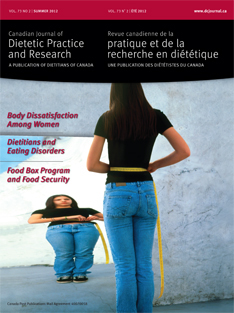Abstract
Purpose: Healthy eating during early childhood is important for growth and development. Eating Well with Canada's Food Guide (CFG) provides dietary recommendations. We investigated patterns of food consumption among preschool children and attempted to determine whether these children's intakes met nutrition recommendations.
Methods: Between 2005 and 2007, four- and five-year-old children (n=2015) attending 12 Edmonton-region public health units for immunization were recruited for a longitudinal study on determinants of childhood obesity. The children's dietary intake at baseline was assessed using parental reports.
Results: Overall, 29.6%, 23.5%, 90.9%, and 94.2% of the children met recommendations for vegetables and fruit, grain products, milk and alternatives, and meat and alternatives, respectively. In addition, 79.5% consumed at least one weekly serving of foods in the “choose least often” group. Significant differences existed in consumption of food groups across socioeconomic and demographic groups. For example, 82.9%, 84.7%, and 75.9% of preschool children from neighbourhoods of low, medium, and high socioeconomic status, respectively, consumed at least one food in the “choose least often” group (χ2 =16.2, p<0.001).
Conclusions: Consumption of vegetables and fruit and grain products was low among participants, and intake of “choose least often” foods was high. Consumption of foods also differed among socioeconomic and demographic groups. To encourage healthy eating among children, public health professionals should target groups who do not meet the CFG recommendations.
Résumé
Objectif: Une saine alimentation est importante pendant la petite enfance pour favoriser le développement et la croissance. Le Guide alimentaire canadien (GAC) fournit des recommandations alimentaires. Nous avons étudié les habitudes de consommation d'aliments chez des enfants d’âge préscolaire et avons tenté de déterminer si l'apport de ces enfants était conforme aux recommandations nutritionnelles.
Méthodes: Entre 2005 et 2007, des enfants de 4 et 5 ans (n = 2015) ayant visité l'une des 12 unités de santé publique de la région d'Edmonton pour une immunisation ont été recrutés pour une étude longitudinale sur les déterminants de l'obésité infantile. L'apport alimentaire des enfants au début de l’étude était évalué sur la base d'information fournie par les parents.
Résultats: Globalement, 29,6 %, 23,5 %, 90,9 % et 94,2 % des enfants satisfaisaient aux recommandations relatives aux groupes Légumes et fruits, Produits céréaliers, Lait et substituts et Viandes et substituts, respectivement. De plus, 79,5 % consommaient au moins une portion par semaine d'aliments de la catégorie « à choisir moins souvent ». Des différences significatives existaient sur le plan de la consommation associée aux groupes alimentaires selon les groupes socioéconomiques et démographiques. Par exemple, 82,9 %, 84,7 % et 75,9 % des enfants d’âge préscolaire provenant de quartiers caractérisés par un statut socioéconomique faible, moyen et élevé, respectivement, consommaient au moins un aliment du groupe « à choisir moins souvent » (χ2 = 16,2, p < 0,001).
Conclusions: La consommation de légumes et fruits et de produits céréaliers était faible chez les participants, et l'apport en aliments du groupe « à choisir moins souvent » était élevé. La consommation d'aliments différait également selon les groupes socioéconomiques et démographiques. Pour promouvoir une saine alimentation chez les enfants, les professionnels de la santé publique devraient cibler les groupes qui ne satisfont pas aux recommandations du GAC.



